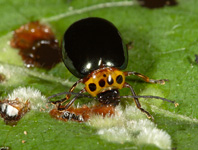Abstract
The macrosetae of the ventral plate of Laniatores penis have been occasionally described and used for systematic purposes in the literature, to the point of having a whole system created for them in the recent study Of Kury & Villarreal (2015), in a paper where a phylogenetic analysis of the subfamily Gonyleptoidea was performed. Contrastingly, the microsetae of ventral plate of Gonyleptoidea are left undescribed in descriptive works, where the penis is often illustrated without a ventral view of the ventral plate. In some works with SEM images microsetae do appear, although they remain undescribed and/or unacknowledged (e.g., Townsend et al., 2010 figs 8–10; Coronato-Ribeiro & Pinto-da-Rocha 2015, where microsetae are visible in photos, but only barely mentioned). In the case of line drawings, exceptionally a few microsetae are shown mainly in the lateral view of the penis ventral plate (Acosta 2001, figs 17–21; Weber 1988, fig 6b). Exceptions to this treatment are Kury (2012: 41, figs 14–15) in which besides microsetae are illustrated their distribution pattern is described and Kury (2014), where even a subgroup of Gonyleptoidea was created and named—Microsetata—for species possessing a mat of microsetae on the ventral surface of ventral plate. Furthermore, among the characters used for the analysis in Kury & Villarreal (2015), the authors listed one containing five types of microsetae, which were not explained. Here, these types and their topology are described to make up for that omission.
References
Acosta, L.E. (2001) The identity of Acrographinotus erectispina, with a review of the generic diagnosis, and the description of a new species (Opiliones, Gonyleptidae, Pachylinae). Bulletin of the British Arachnological Society, 12 (2), 58–66.
Coronato-Ribeiro, A. & Pinto-da-Rocha, R. (2015) Four new species of Cosmetus from Panama, with comments on the systematics of the genus (Opiliones: Cosmetidae). Zoologia, 32 (5), 409–422.
http://dx.doi.org/10.1590/S1984-46702015000500010Ferreira, C.P. & Kury, A.B. (2010) A review of Roquettea, with description of three new Brazilian species and notes on Gryne (Opiliones, Cosmetidae, Discosomaticinae). Zoological Science, 27, 697–708.
http://dx.doi.org/10.2108/zsj.27.697Kury, AB (2012) A new genus of Cranaidae from Ecuador (Opiliones: Laniatores). Zootaxa, 3314, 31–44.
Kury, A.B. (2014) Why does the Tricommatinae position bounce so much within Laniatores? A cladistic analysis, with description of a new family of Gonyleptoidea (Opiliones, Laniatores). Zoological Journal of the Linnean Society, 172, 1–48.
http://dx.doi.org/10.1111/zoj.12165Kury, A.B. & Carvalho, R.N. (2016) Revalidation of the Brazilian genus Discocyrtanus, with description of two new species (Opiliones: Gonyleptidae: Pachylinae). Zootaxa, 4111 (2), 126–144.
http://dx.doi.org/10.11646/zootaxa.4111.2.2Kury A.B. & Villarreal, M.O. (2015) The prickly blade mapped: establishing homologies and a chaetotaxy for macrosetae of penis ventral plate in Gonyleptoidea (Arachnida, Opiliones, Laniatores). Zoological Journal of the Linnean Society, 174 (1), 1–46.
http://dx.doi.org/10.1111/zoj.12225Monteiro, Y.F. & Pinto-Da-Rocha, R. (2015) Revision of the genus Ferkeria Roewer, 1947, with the description of a new species (Opiliones: Laniatores: Cosmetidae). Zootaxa, 4006 (2), 361–373.
http://dx.doi.org/10.11646/zootaxa.4006.2.7Montemor, V.M., Bragagnolo, C. & Pinto-da-Rocha, R. (2015) Taxonomic review of the Neotropical genus Neopachylus (Arachnida, Opiliones, Gonyleptidae). Iheringia, Série Zoologia, 105 (1), 101–121.
http://dx.doi.org/10.1590/1678-476620151051101121Pinto-da-Rocha, R., Benedetti, A.R. Vasconcelos, E.G. & Hara, M.R. (2012) New systematic assignments in Gonyleptoidea (Arachnida, Opiliones, Laniatores). ZooKeys, 198, 25–68.
http://dx.doi.org/10.3897/zookeys.198.2337Townsend Jr., V.R., Víquez, C., Vanzandt, P.A. & Proud, D.N. (2010) Key to the Species of Cosmetidae (Arachnida, Opiliones) of Central America, with Notes on Penis Morphology and Sexual Dimorphisms. Zootaxa, 2414, 1–26.
Townsend Jr., V.A., Milne, M.A. & Proud, D.N. (2011) Two new species of Manaosbiidae (Opiliones: Laniatores) from Panama, with comments on interspecific variation in penis morphology. The Journal of Arachnology, 39, 92–101.
http://dx.doi.org/10.1636/Ha09-26.1Weber, M. (1988) Die Phalangodidae – eine polyphyletische Familie der Gonyleptoidea? Unpublished BSc Thesis, Fakultät für Biologie, Universität Tübingen. [unkown pagination]

